We’ve all heard the roar of a classic sports car that makes heads turn and hearts race. Triumph cars represent that perfect blend of British engineering excellence and automotive passion that defined an era of motoring history.
From the iconic TR series roadsters to the beloved Spitfire and GT6, Triumph built vehicles that weren’t just transportation – they were statements of style and performance. These weren’t cars for the faint-hearted; they were crafted for drivers who understood that the journey mattered just as much as the destination.
Whether you’re a seasoned collector searching for your next restoration project or simply curious about what made these British legends so special, we’re here to guide you through the intriguing area of Triumph automobiles. Let’s explore why these cars continue to capture enthusiasts’ imaginations decades after the last one rolled off the production line.
The Birth of Triumph Cars: From Bicycle Makers to Automotive Icons
The legendary British marque we know today began its journey far from the automotive industry. Understanding Triumph’s origins reveals how determination and innovation transformed a small bicycle company into one of Britain’s most celebrated car manufacturers.
Early Company History and Founding
Siegfried Bettmann established the Triumph brand in 1885 in Coventry, England, initially focusing on bicycle manufacturing. The German immigrant chose the name “Triumph” to convey victory and success across international markets. Bettmann partnered with Moritz Schulte in 1886, creating the foundation for what would become a British automotive legend.
We see the company’s early success stemming from Bettmann’s marketing genius and quality craftsmanship. Triumph bicycles quickly gained recognition for their reliability and innovative design features. The company expanded rapidly throughout the 1890s, establishing distribution networks across Europe and beyond.
Financial stability came through strategic business decisions and consistent product quality. Bettmann’s vision extended beyond simple bicycle manufacturing, as he recognized the potential for mechanical innovation in transportation. The Coventry location provided access to skilled engineering talent and manufacturing infrastructure that would prove crucial for future expansion.
Transition From Bicycles to Motorcycles to Cars
Triumph entered motorcycle production in 1902, marking the company’s first major diversification from bicycles. The early motorcycles featured engines sourced from Belgian manufacturer Minerva, demonstrating Triumph’s pragmatic approach to entering new markets. We observe how this strategic move positioned the company for eventual automotive manufacturing.
Motorcycle success accelerated throughout the 1900s as Triumph developed its own engine technology and racing capabilities. The company achieved important victories in motorcycle competitions, building brand recognition and technical expertise. Racing success translated into commercial popularity, with Triumph motorcycles becoming synonymous with performance and reliability.
Industry War I created both challenges and opportunities for the expanding company. Triumph supplied motorcycles to military forces while simultaneously developing automotive ambitions. The war years provided valuable experience in large scale manufacturing and government contracts that would benefit future car production.
Automotive manufacturing began in 1923 with the introduction of the Triumph 10/20 model. We witness the company’s careful transition from two wheels to four, leveraging existing mechanical expertise and manufacturing capabilities. The first Triumph cars featured conventional engineering approaches while incorporating the quality standards established through bicycle and motorcycle production.
Early automotive models demonstrated Triumph’s commitment to affordable luxury and sporting character. The company positioned itself between basic transportation and expensive luxury vehicles, creating a distinctive market niche. This strategic positioning would define Triumph cars throughout their production history.
Classic Triumph Sports Cars That Defined an Era
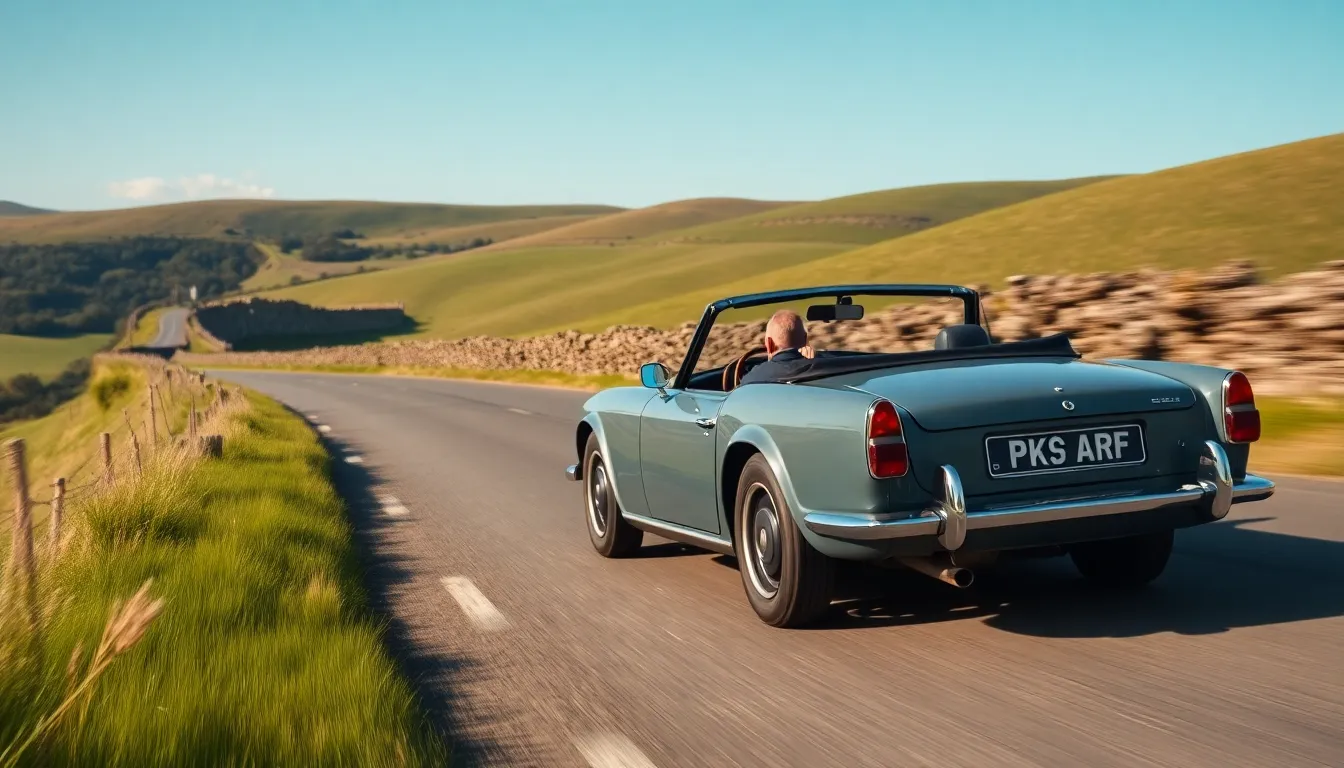
Building on Triumph’s automotive foundation from the 1920s, the company’s greatest achievements emerged in the sports car arena. These legendary models transformed Triumph from a modest car manufacturer into an icon of British automotive excellence.
Triumph TR Series Legacy
TR2 revolutionized British sports cars when it debuted in 1953 with its 2.0-liter engine producing 90 horsepower. We’ve witnessed how this model established Triumph’s reputation for affordable performance, reaching speeds of 103 mph at a fraction of competitors’ costs.
TR3 enhanced the formula in 1955 by adding front disc brakes and increasing power to 95 horsepower. Racing success followed immediately, with TR3 models dominating their class at Le Mans and Sebring throughout the late 1950s.
TR4 introduced modern styling in 1961 through collaboration with Italian designer Giovanni Michelotti. Independent rear suspension and roll-up windows replaced the TR3’s outdated features, while the 2.1-liter engine delivered 100 horsepower.
TR6 became the series pinnacle from 1968 to 1976, featuring a fuel-injected 2.5-liter inline-six engine producing 150 horsepower in UK specification. Sales figures reached 94,619 units worldwide, making it the most successful TR model ever produced.
Triumph Spitfire and GT6 Models
Spitfire captured hearts as Triumph’s smallest sports car when production began in 1962. Michelotti’s design created an elegant silhouette around the Herald chassis, while the 1.1-liter engine provided nimble performance perfect for winding country roads.
GT6 transformed the Spitfire concept by adding a removable hardtop and the TR4’s 2.0-liter six-cylinder engine in 1966. Power output reached 95 horsepower, enabling 0-60 mph acceleration in 10.9 seconds and a top speed of 106 mph.
Spitfire Mark IV improvements arrived in 1970 with a redesigned rear suspension addressing earlier handling concerns. Production continued until 1980, with total Spitfire output reaching 314,342 units across all variants.
GT6 Mark III refinements in 1970 included improved suspension geometry and interior appointments. Even though producing only 40,926 GT6 models total, these cars developed a devoted following among enthusiasts seeking six-cylinder performance in a compact package.
Triumph Herald and Vitesse Lines
Herald introduced body-on-frame construction in 1959 as Triumph’s answer to BMC’s unibody designs. Michelotti’s styling created clean lines around a separate chassis, while the 948cc engine provided economical transportation with sporting character.
Vitesse elevated Herald performance in 1962 by installing the TR4’s 2.0-liter six-cylinder engine producing 70 horsepower. Twin carburetors and revised suspension transformed the Herald platform into a genuine sports sedan capable of 90 mph.
Herald 13/60 represented the line’s peak with a 1.3-liter engine producing 61 horsepower in 1967. Independent front suspension and rack-and-pinion steering provided excellent handling characteristics that impressed automotive journalists worldwide.
Vitesse Mark 2 concluded production in 1971 after selling 51,212 units across both generations. These models demonstrated Triumph’s ability to create sporting derivatives from practical family cars, establishing a template later used for the acclaimed Dolomite Sprint.
Engineering Excellence: What Made Triumph Cars Stand Out
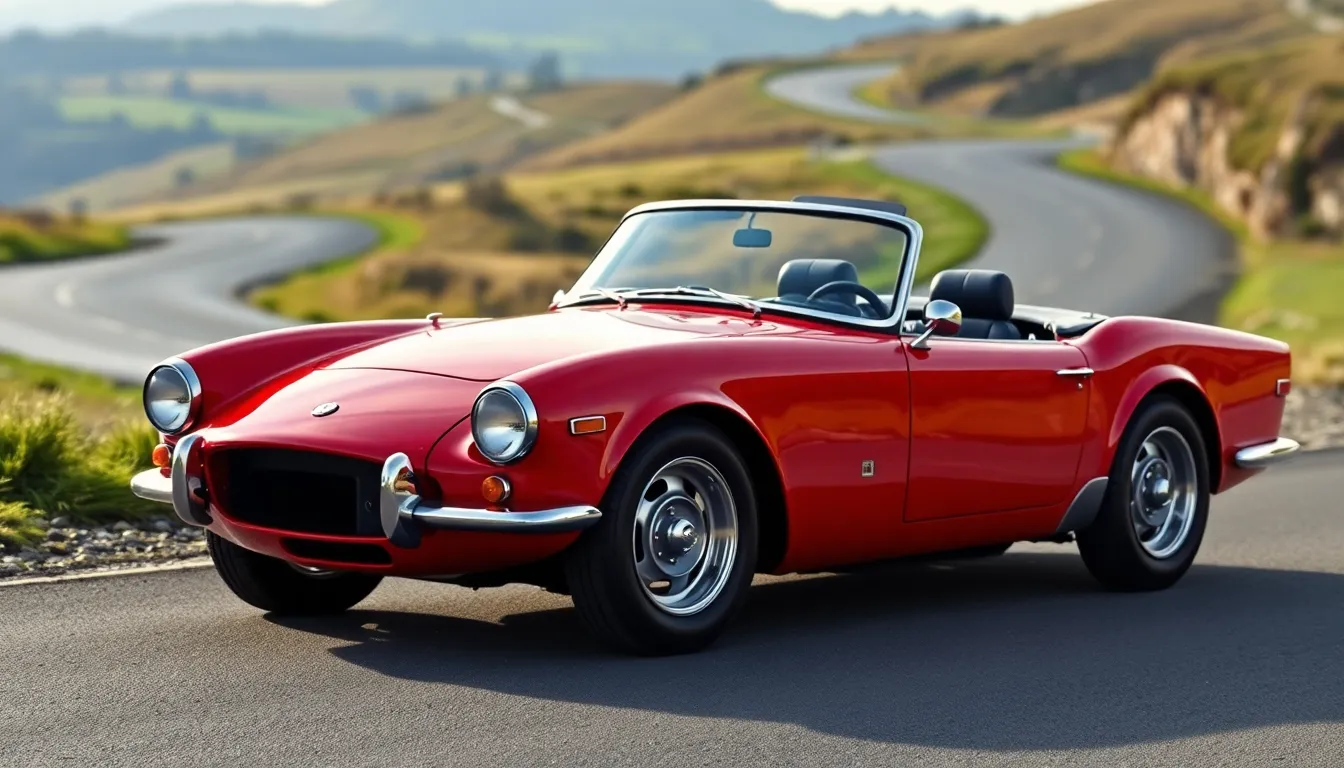
Behind every memorable Triumph model lay sophisticated engineering answers that distinguished these British sports cars from their competitors. Our exploration of Triumph’s technical achievements reveals why enthusiasts still celebrate these vehicles decades after production ended.
Innovative Engine Technologies
Triumph’s engineering team developed powerplants that balanced performance with reliability in remarkable ways. The twin-carburetor setup on TR series engines delivered exceptional throttle response while maintaining fuel efficiency across various driving conditions. Six-cylinder inline engines became Triumph’s signature, producing smooth power delivery that competitors struggled to match with their four-cylinder alternatives.
Advanced combustion chamber design in Triumph engines featured hemispherical heads that improved airflow and increased compression ratios. Engineers optimized valve timing to extract maximum power from relatively small displacement engines, allowing the TR6’s 2.5-liter unit to produce 150 horsepower. Wet sleeve cylinder construction simplified maintenance while ensuring consistent bore dimensions throughout the engine’s lifespan.
Cooling system innovations included strategically placed thermostats and efficient radiator designs that prevented overheating during spirited driving. Triumph’s engineers positioned oil coolers to maintain optimal operating temperatures even under racing conditions. Electronic ignition systems replaced traditional points-based setups in later models, improving reliability and reducing maintenance requirements.
Distinctive Design Philosophy
Michelotti’s influence shaped Triumph’s aesthetic direction, creating timeless profiles that emphasized flowing lines over aggressive angles. Clean bodywork eliminated unnecessary decorative elements while maintaining visual appeal through proportional excellence. Chrome accents appeared strategically rather than excessively, highlighting key design features without overwhelming the overall composition.
Functional aerodynamics guided body panel development, with engineers testing airflow patterns to reduce drag while maintaining stability. Triumph designers integrated air vents and scoops that actually improved cooling rather than serving purely cosmetic purposes. Wind tunnel testing influenced windshield angles and rear deck slopes, resulting in improved high-speed handling characteristics.
Interior ergonomics received careful attention, with controls positioned for intuitive operation during enthusiastic driving. Bucket seats provided proper support while maintaining comfort during extended journeys. Dashboard layouts prioritized essential gauges while eliminating clutter that might distract drivers during performance driving situations.
| Design Element | Function | Model Examples |
|---|---|---|
| Low hood line | Improved visibility | TR4, TR6, Spitfire |
| Integrated bumpers | Weight reduction | GT6, Herald |
| Wraparound windshields | Better aerodynamics | TR4, TR250 |
Racing Heritage and Performance Focus
Competition programs directly influenced production car development, with lessons learned on racetracks translating into improved street vehicles. Factory-backed racing teams provided valuable feedback about suspension tuning, brake performance, and engine reliability under extreme conditions. Victory at Le Mans and other prestigious events validated Triumph’s engineering choices and attracted performance-oriented customers.
Suspension development benefited from racing experience, with independent rear suspension systems appearing on GT6 and TR4 models. Engineers refined spring rates and damper settings based on competitive feedback, creating handling characteristics that excelled on both smooth highways and challenging mountain roads. Anti-roll bars and improved geometry reduced body roll while maintaining ride comfort.
Braking systems evolved through racing applications, with disc brakes becoming standard equipment rather than optional extras. Triumph’s engineers developed brake bias adjustments that prevented premature lockup during aggressive stopping maneuvers. Ventilated rotors and high-performance pad compounds ensured consistent stopping power during extended track sessions.
Transmission engineering produced robust gearboxes capable of handling increased power outputs from modified engines. Overdrive units became Triumph specialties, providing relaxed highway cruising without sacrificing acceleration in lower gears. Close-ratio gear sets allowed drivers to keep engines in their power bands during competitive driving situations.
Most Collectible Triumph Cars Among Enthusiasts Today
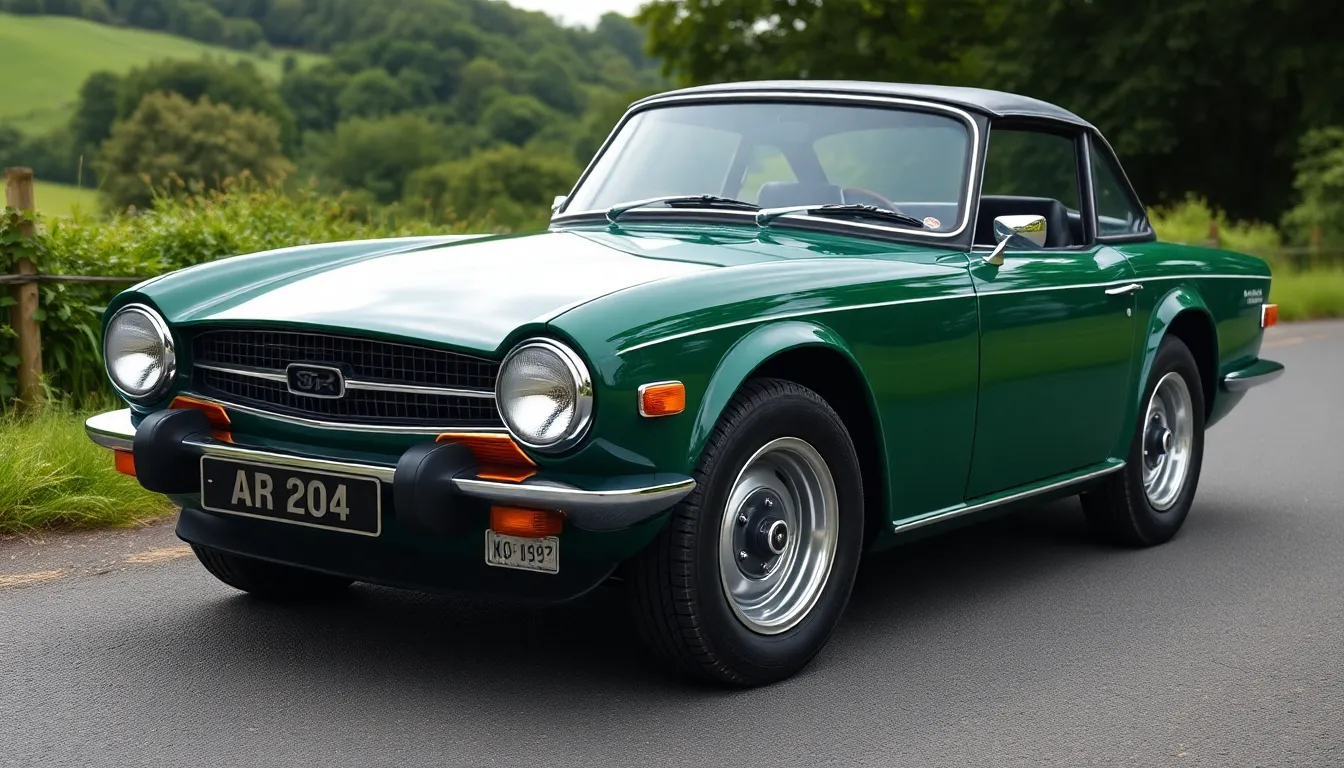
Triumph cars continue to command impressive values in today’s collector market, driven by their racing heritage and British engineering excellence. We’ve analyzed market trends to identify which models deliver the strongest investment potential and collector appeal.
Triumph TR6 Market Value and Appeal
Triumph TR6 models consistently rank as the most valuable among TR series cars, with pristine examples fetching $30,000 to $85,000 at auction. We observe that original 1969-1976 TR6s with matching numbers command premium prices, particularly those featuring the coveted fuel injection system and overdrive transmission. Collectors prize these vehicles for their muscular styling, reliable 2.5-liter inline-six engine, and comfortable touring capabilities.
Market data reveals exact TR6 variants achieve exceptional values, including early production models and those with rare factory options like hardtops or wire wheels. We track restored concours-quality examples selling for $60,000 to $85,000, while solid driver-condition cars typically range from $25,000 to $45,000. British Racing Green and Signal Red remain the most sought-after colors among serious collectors.
Investment potential remains strong for quality TR6 examples, as production numbers totaled only 94,619 units over seven years. We notice particular demand for low-mileage, well-documented cars with comprehensive service records and original components intact.
Rare Limited Edition Models
Triumph TR5 represents the holy grail of TR collecting, with only 2,947 examples produced exclusively for the UK market between 1967-1968. We’ve witnessed auction prices reach $150,000 for exceptional TR5s, making them among the most valuable production Triumphs ever built. These cars feature the legendary Lucas fuel-injected 2.5-liter engine producing 150 horsepower.
Limited production Spitfire variants command important premiums, including the 1500cc models from the final production years and special edition versions like the Inca Yellow 1980 Spitfire. We observe that complete, original examples of these rare variants sell for 40-60% more than standard Spitfires.
Triumph GT6 Mark III models achieve exceptional collector status, particularly those equipped with the Rotoflex rear suspension system. We track pristine examples selling for $35,000 to $55,000, reflecting their combination of Spitfire styling with genuine GT performance capabilities.
Restoration-Worthy Classic Triumphs
Triumph Herald convertibles offer excellent restoration potential, with project cars starting around $3,000 to $8,000 for complete examples needing comprehensive work. We recommend these models for first-time restorers due to their simple construction, readily available parts, and forgiving nature during the restoration process. Finished Herald restorations typically achieve $18,000 to $28,000 values.
Early Triumph TR4 and TR4A models present outstanding investment opportunities, especially those with original IRS (Independent Rear Suspension) systems intact. We find solid restoration candidates priced between $8,000 and $15,000, while completed restorations command $35,000 to $55,000 depending on quality and authenticity.
Triumph Stag restoration projects require careful evaluation, as these V8-powered convertibles face exact challenges including cooling system issues and engine complexity. We suggest focusing on examples with documented engine rebuilds or V8 conversions, as properly restored Stags achieve $25,000 to $45,000 values in today’s market.
Triumph Cars in Popular Culture and Media
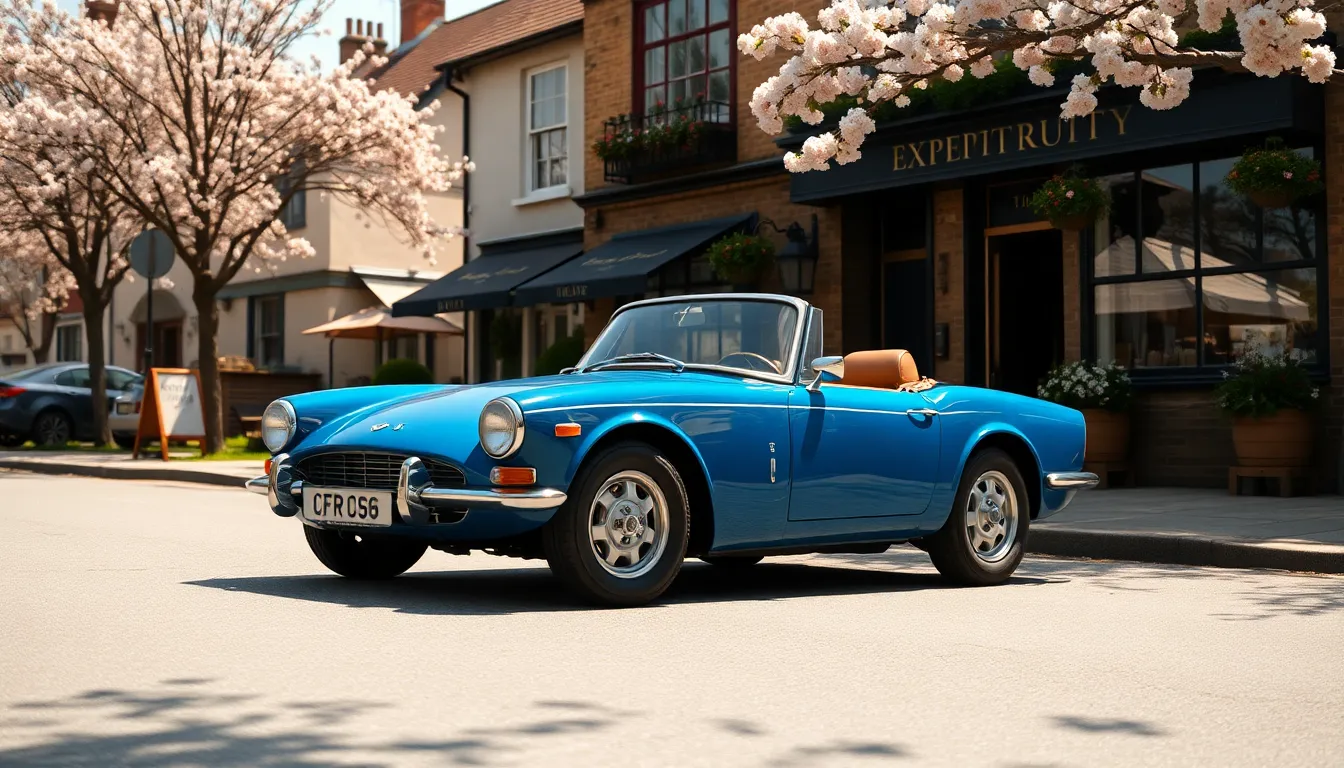
Triumph cars have transcended their mechanical origins to become cultural icons, appearing across various forms of entertainment and capturing the imagination of audiences worldwide.
Hollywood Movie Appearances
Austin Powers films feature the most recognizable Triumph in cinema history. The blue Triumph Spitfire driven by Mike Myers became synonymous with 1960s British cool and helped introduce Triumph sports cars to a new generation of viewers.
The Italian Job (1969) showcases Triumph motorcycles during the famous Mini Cooper chase scenes. These motorcycles provided additional British flair to the film’s celebration of British engineering prowess.
James Bond films occasionally featured Triumph vehicles as background elements in various scenes. Several TR series models appeared in crowd shots and establishing shots throughout the franchise’s early years.
British television crime dramas regularly incorporated Triumph cars as period-appropriate vehicles. Productions set in the 1960s and 1970s often used TR6 models and Spitfires to establish authentic historical context.
| Film/Show | Triumph Model | Year | Notable Scene |
|---|---|---|---|
| Austin Powers | Spitfire 1500 | 1997 | Opening sequence |
| The Italian Job | Bonneville motorcycles | 1969 | Chase scenes |
| Various Bond films | TR6 | 1970s | Background vehicles |
Celebrity Owners and Famous Drivers
Steve McQueen owned multiple Triumph motorcycles throughout his career. His passion for British engineering extended beyond his famous automotive collection to include several rare Triumph Bonneville models.
Princess Margaret drove a Triumph TR4 during the 1960s. Her choice of this particular sports car helped cement Triumph’s reputation among British high society and influenced public perception of the brand.
Racing driver Jackie Stewart campaigned Triumph-powered Formula Junior cars early in his career. His success with these vehicles demonstrated Triumph’s engineering capabilities in professional motorsport.
Rock musicians frequently chose Triumph cars as personal transportation. Members of The Who, The Rolling Stones, and other British bands were often photographed with their TR6 and Spitfire models.
Television presenter Jeremy Clarkson has praised Triumph cars in various automotive programs. His commentary on classic Triumph models has helped maintain public interest in the brand decades after production ended.
Television Show Features
Classic car restoration shows frequently feature Triumph projects due to their popularity among enthusiasts. Programs like “Wheeler Dealers” and “Car SOS” have restored multiple TR6 models and Spitfires for grateful owners.
Period dramas set in post-war Britain regularly include Triumph cars as authentic props. Shows depicting the 1960s and 1970s often feature Herald models and TR series sports cars to establish historical accuracy.
Documentary programs about British automotive history dedicate important segments to Triumph’s legacy. These productions explore the company’s impact on sports car development and its role in British manufacturing heritage.
Vintage racing coverage showcases Triumph cars competing in historic motorsport events. Television broadcasts of Goodwood Revival and similar events regularly feature TR series cars and competition Spitfires.
Automotive magazine shows frequently review restored Triumph models and discuss their significance in motoring history. These programs help educate viewers about Triumph’s engineering innovations and cultural importance.
The Decline and End of Triumph Car Production
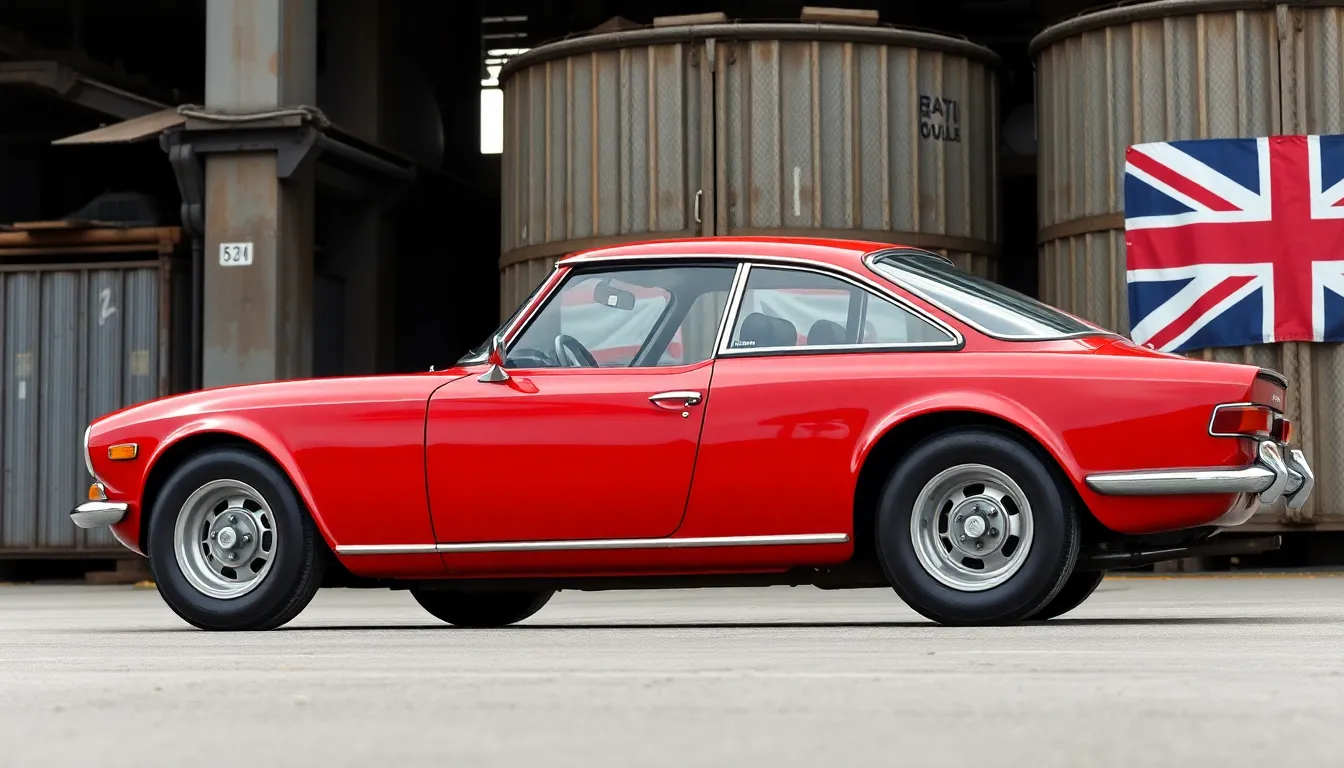
The golden age of Triumph cars couldn’t last forever, and by the 1970s, mounting challenges began threatening the company’s survival. We’ll explore how financial pressures and industry changes eventually led to the end of an automotive legend.
Financial Struggles and Ownership Changes
Leyland Motor Corporation’s acquisition of Triumph in 1960 initially seemed promising, but it marked the beginning of a turbulent ownership period. British Leyland formed in 1968 through a government-backed merger, creating a massive conglomerate that struggled with internal competition and resource allocation. We witnessed Triumph competing directly with MG and Austin-Healey within the same corporate family, diluting marketing efforts and confusing consumers.
Strike actions plagued British Leyland throughout the 1970s, severely disrupting production schedules and damaging Triumph’s reputation for reliability. Quality control issues emerged as workers faced job insecurity and management focused more on cost-cutting than craftsmanship. Oil crisis impacts in 1973 and 1979 devastated sports car sales globally, hitting Triumph’s core market particularly hard.
Government intervention became necessary in 1975 when British Leyland required a £1.4 billion bailout to avoid bankruptcy. Political pressure mounted for the company to focus on volume production rather than niche sports cars. Market share declined steadily as Japanese manufacturers like Datsun and Toyota offered more reliable alternatives at competitive prices.
Final Models and Production Cessation
Triumph’s last hurrah came with the TR7 launch in 1975, featuring controversial wedge-shaped styling that divided enthusiasts. Production moved from Liverpool to Canley and finally to Solihull as British Leyland attempted to streamline operations. We saw quality issues plague early TR7 models, including electrical problems and body panel alignment issues that frustrated longtime Triumph customers.
TR8 development began in 1977 with a Rover V8 engine, but production remained limited to just 2,497 units between 1978 and 1981. Acclaim sedan launched in 1981 as a Honda Ballade rebadge, representing Triumph’s final attempt at volume production but lacking the sporting character that defined the brand. Spitfire production ended in August 1980 after 314,342 units, marking the conclusion of Triumph’s longest-running sports car line.
| Final Production Numbers | Units Produced | Production End |
|---|---|---|
| TR7 | 112,368 | October 1981 |
| TR8 | 2,497 | October 1981 |
| Spitfire 1500 | 95,829 | August 1980 |
| Acclaim | 133,625 | July 1984 |
TR7 and TR8 production ceased in October 1981 when British Leyland decided to focus resources on more profitable volume cars. Acclaim continued until July 1984, but it represented Honda engineering rather than traditional Triumph values.
Legacy Impact on British Automotive Industry
Triumph’s demise symbolized the broader decline of British sports car manufacturing in the early 1980s. MG faced similar challenges within British Leyland, with the MGB ending production in the same period as Triumph’s sports cars. We observed how Japanese manufacturers filled the void left by British brands, offering reliability and build quality that domestic producers had failed to maintain.
Engineering talent dispersed throughout the industry after Triumph’s closure, with many designers and engineers joining other manufacturers or establishing specialist companies. Michelotti’s styling influence lived on through his work with other brands, while former Triumph engineers contributed to projects at Rover, Jaguar, and independent specialists.
Classic car values began rising in the 1990s as enthusiasts recognized Triumph’s historical significance and mourned the loss of accessible British sports cars. Restoration industry growth created new businesses specializing in Triumph parts and services, keeping the marque alive in spirit if not in production. We’ve seen how Triumph’s legacy influenced modern retro-styled sports cars from manufacturers attempting to recapture that classic British roadster appeal.
Parts availability remains strong today through specialist suppliers and club networks, ensuring Triumph cars continue operating on roads worldwide. Heritage organizations preserve technical knowledge and manufacturing techniques that defined Triumph’s approach to sports car development.
Modern Triumph Car Collecting and Restoration Scene
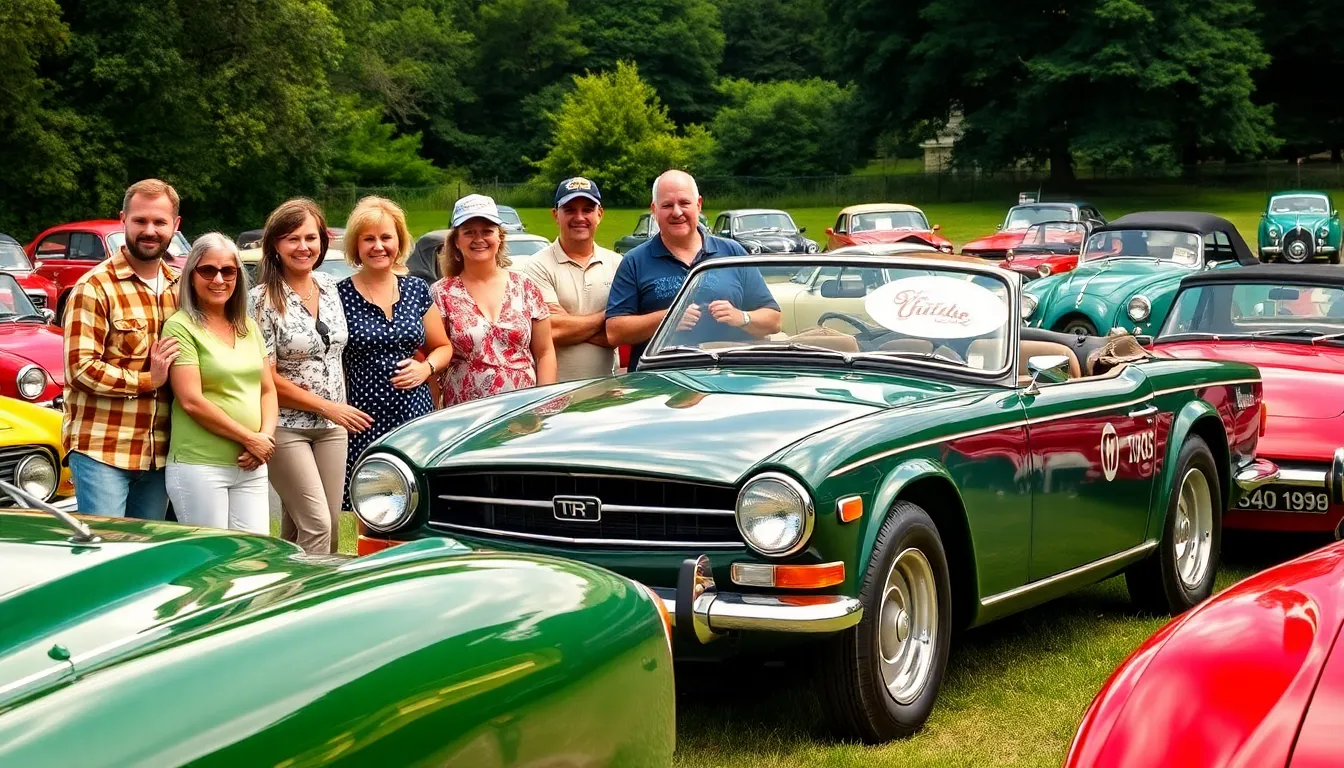
Today’s Triumph enthusiast community thrives even though the brand’s absence from modern showrooms. We find ourselves part of a passionate global network that keeps these classic British sports cars alive through dedicated restoration efforts and shared expertise.
Active Owner Communities and Clubs
Triumph Register of America serves as the primary organization for North American enthusiasts, boasting over 3,000 members across regional chapters. Local chapters organize monthly meetings, technical seminars, and driving events that connect owners with similar interests. National conventions draw hundreds of participants annually, featuring concours competitions, swap meets, and restoration workshops.
British sports car clubs often welcome Triumph owners alongside MG and Austin Healey enthusiasts, creating diverse communities centered on shared mechanical knowledge. Regional groups like the Chicago Area Triumph Owners Association and Southern California Triumph Owners Association host regular gatherings at automotive museums and private collections. Online forums such as TriumphExp.com and Classic Motoring Forum provide 24/7 technical support and parts sourcing assistance from experienced restorers.
Specialized model clubs focus on exact Triumph lines, with the TR Register maintaining detailed chassis records and technical specifications for TR series cars. Spitfire and GT6 Magazine connects small sports car enthusiasts through quarterly publications and annual meets. Herald and Vitesse clubs preserve knowledge about these unique unibody construction models, sharing restoration techniques exact to their chassis designs.
Parts Availability and Restoration Resources
Moss Motors leads the aftermarket parts industry, offering comprehensive catalogs with over 95% availability for popular models like the TR6 and Spitfire. Their technical support team provides installation guidance and compatibility information for both original equipment and improved replacement components. British Parts Northwest and The Roadster Factory compete in this space, maintaining extensive inventories of mechanical, electrical, and body restoration parts.
Specialized manufacturers produce high quality reproductions of discontinued items, including complete wiring harnesses, interior trim pieces, and body panels. Companies like Martin Robey and Euro Car Parts focus specifically on British automotive restoration, ensuring proper fitment and authentic materials. Heritage parts programs through Jaguar Land Rover occasionally release original tooling components for select Triumph models.
Technical documentation remains readily available through official workshop manuals, parts catalogs, and restoration guides published by enthusiast organizations. Haynes manuals cover most popular models with detailed step by step procedures for major repairs and maintenance. Online databases like the Triumph Parts Finder help locate exact components across multiple suppliers, while technical bulletins from the original factory period provide authentic repair procedures.
Investment Potential for Classic Triumphs
Market appreciation trends show steady growth for well maintained Triumph models over the past decade, with concours quality examples commanding premium prices at collector car auctions. Barrett Jackson and Bonhams regularly feature restored TR6 models selling between $35,000 and $90,000 depending on originality and condition. Limited production models like the TR5 and TR250 consistently outperform market averages, with exceptional examples reaching $120,000 at recent sales.
Entry level opportunities exist in the Herald, Vitesse, and early Spitfire markets, where solid restoration candidates trade between $8,000 and $15,000. These models offer newcomers affordable access to classic British motoring while providing potential for modest appreciation over time. TR4 and TR4A models represent middle market investments, with restored examples selling for $25,000 to $45,000 based on documentation and mechanical condition.
Rarity factors significantly impact long term values, particularly for factory competition models, low production variants, and cars with documented provenance. Original paint and matching numbers examples command substantial premiums over restored vehicles, reflecting collector preferences for authenticity. Export market demand from European and Australian collectors continues driving prices upward for left hand drive models originally sold in North American markets.
Conclusion
We’ve witnessed how Triumph cars transcend mere transportation to become enduring symbols of automotive passion and British engineering excellence. Their story reminds us that great cars aren’t just built—they’re crafted with soul and purpose.
Today’s thriving enthusiast community proves that Triumph’s spirit lives on through every restored TR6 engine purr and every Spitfire weekend drive. These cars continue connecting generations of drivers who understand that performance and character matter more than perfection.
Whether you’re drawn to their investment potential racing heritage or simply their timeless appeal Triumph cars offer something increasingly rare in today’s automotive industry: genuine personality. They remain proof that the best cars are those that make us feel truly alive behind the wheel.
Frequently Asked Questions
What is the history behind Triumph cars?
Triumph began as a bicycle manufacturer in 1885 in Coventry, England, founded by Siegfried Bettmann. The company transitioned to motorcycles in 1902 and entered car manufacturing in 1923 with the Triumph 10/20 model. Throughout its history, Triumph became synonymous with British engineering excellence and sporting character until production ceased in 1981.
Which Triumph models are considered the most iconic?
The most iconic Triumph models include the TR series (TR2, TR3, TR4, TR6), the Spitfire, and the GT6. The TR6 became the pinnacle of the series with remarkable sales figures, while the Spitfire charmed enthusiasts as the smallest sports car. These models exemplified Triumph’s commitment to affordable performance and distinctive British styling.
What makes Triumph cars valuable to collectors today?
Triumph cars hold strong investment potential, with TR6 models ranging from $30,000 to $85,000 at auction. The rare TR5 can reach up to $150,000, while limited edition Spitfire variants and GT6 Mark III models command significant premiums. Well-maintained examples show steady market appreciation, making them attractive to both collectors and investors.
Why did Triumph stop making cars?
Triumph’s decline began with Leyland Motor Corporation’s acquisition in 1960, leading to internal competition and production disruptions. The oil crises of the 1970s impacted sales, requiring a government bailout in 1975. Quality issues with final models like the TR7 and TR8, combined with financial struggles, led to production ending in 1981.
Are Triumph car parts still available for restoration?
Yes, parts and restoration resources remain widely available for Triumph cars. Companies like Moss Motors lead the aftermarket industry, providing comprehensive parts catalogs. The thriving enthusiast community, including organizations like the Triumph Register of America, offers technical support and maintains knowledge about restoration techniques, ensuring these classic cars can be properly maintained.
What was Triumph’s impact on British automotive culture?
Triumph cars became cultural icons, appearing in films like Austin Powers and being owned by celebrities like Steve McQueen and Princess Margaret. They symbolized British engineering passion and sporting heritage. Even after production ended, Triumph’s legacy continues to influence classic car culture through restoration shows, documentaries, and active enthusiast communities worldwide.
Which Triumph models are best for first-time restorers?
The Triumph Herald and early TR4 models are excellent choices for first-time restorers. These models offer good investment potential while being more accessible than higher-end variants. Their simpler mechanical systems and available documentation make them ideal learning platforms, with strong community support and readily available parts for restoration projects.
How did Triumph’s racing heritage influence their road cars?
Triumph’s competition programs directly informed production car development. Racing feedback led to advancements in suspension systems, braking technology, and transmission engineering. The TR series particularly benefited from racing experience, with innovations in engine design, aerodynamics, and handling characteristics that were developed on the track and applied to road cars.

